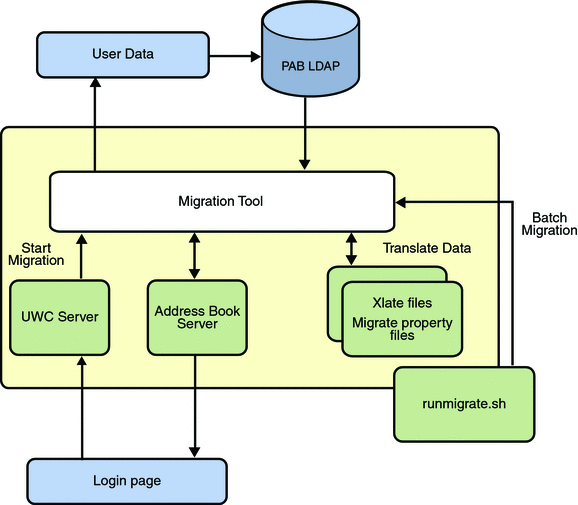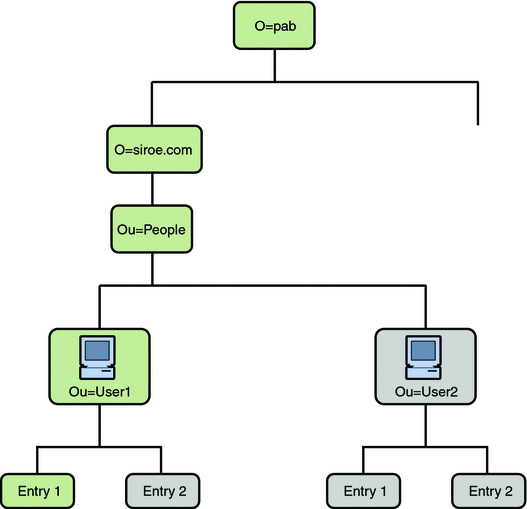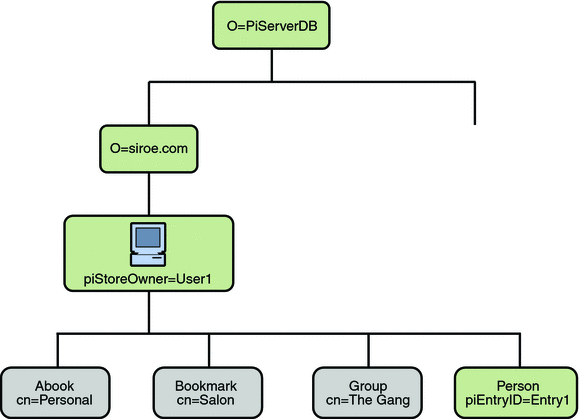Chapter 7 Migrating Personal Address Book Data to Address Book Server
Previously, Personal Address Book (PAB) was used to store the user’s contacts in Sun Java System Messaging Server and PAB could be accessed only by web-based clients deployed on Messaging Server. The Messaging Server for Communications Express uses Address Book server instead of PAB to store users’ contact details. Because of this, users accessing Communications Express using the existing Messaging Server installations must migrate their PAB data to the Address Book Server.
Migration Deployment Scenarios
-
A single Messenger Express instance pointing to the default single PAB host.
-
A single Messenger Express instance pointing to multiple PAB hosts.
-
A single Messenger Express instance pointing to multiple PAB hosts with the default PAB host set.
-
Multiple Messenger Express instances pointing to single PAB host.
-
Multiple Messenger Express instances pointing to multiple PAB hosts.
Migration can be performed from:
Migration Scenarios
Data Migration takes place in two ways:
Dynamic Migration
Dynamic Migration takes place when an existing Messenger Express user logs in to Communications Express. The Users receive an email after the migration is completed.
-
The application checks if migration has been enabled in the uwcuath.properties file by checking the pab_mig_required parameter.
If the pab_mig_required parameter is set to true, the migration process is initiated.
-
The login logic then compares the nswmextendedprefs attribute in the user's LDAP entry. It checks for the value of the mepabmigration parameter to determine whether the user’s data has been previously migrated.
-
Once PAB migration is completed, the Address Book Server sets the nswmextendedprefs, mepabmigration properties to 1 in the logged in user entry, to indicate the completion of the migration process.
-
The user receives a mail after the PAB data is successfully migrated to the Address Book Server.
In the dynamic migration process:
To receive a mail, you are required to set the parameters in the migrate.properties file.
Table 7–1 PAB Migration Email Parameters|
Parameters |
Default Value |
Description |
|---|---|---|
|
emailReqd |
True |
Enables mail to be sent after the PAB data has been migrated successfully. Accepted values are “True” and “False”. |
|
smtphost |
local mail host For example: budgie.siroe.com |
Specifies the SMTP relay host name. |
|
smtpport |
25 |
Specifies the SMTP relay port. |
|
mailsubject |
PAB Migration Status |
Specifies the subject of the mail. |
|
from |
admin@hostname |
Specifies the sender’s name. |
Tip –
It is recommended that the administrator sends an email to all users informing them that PAB data migration will be triggered during the first login and as a consequence they will not see the Address Book data during the initial sessions. Users should contact the administrator if they are unable to see their data after 2 or 3 days.
Batch Migration
In the batch migration process, migration takes place at the server level without end user interaction. The administrator executes the runMigrate.sh batch script to migrate the mail users PAB data present in a given domain. For mail users present in multiple domains, the administrator will have to invoke the runMigrate.sh script for each domain to migrate users PAB data from the given inetDomainBaseDN to the Address Book Server.
To Perform Batch Migration
Set the following parameters in the runMigrate.sh script. This script is available at uwc-deployed-path/WEB-INF/classes directory.
-
BASE_DIR: Set this parameter to the uwc-deployed-path of the Communications Express installation.
-
JAVA_HOME: Set this parameter to the directory where Java is installed.
-
o=siroe.com, o=isp: Replace the values for siroe.com and isp to the inetDomainBaseDN for your configured domain.
Execute the batch migration script.
# ./runMigrate.sh |
If the batch migration fails, exceptions are displayed at the command line prompt.
Migrating a Single User and a Set of Users
Using the migration script, administrators can migrate all the users, a single user, or a set of users. Running the batch migration script without any options migrates the entire set of users. To migrate a single user, you can specify the userid of the user. To migrate a set of users, you should provide the list of users in a text file. The runMigrate.sh command has the following syntax:
./runMigrate.sh{ [-u < [uid] | [-f <uids-file]} [-h]
where:
-
-u option tells the runMigrate script that you want to migrate a single user. The —u option should be followed by the userid of the user who you want to migrate. Here is an example:
./runMigrate.sh -u user1
-
-f option tells the runMigrate script that you want to migrate a set of users that have been specified in a file. The —f option should be followed by the name of the file that contains the userids of the selected set of users who you want to migrate. Here is an example:
./runMigrate.sh -f usersToMigrate.txt
The usersToMigrate.txt file should contain one userid on a single line. For example:
user1 user2 user3 ... .... and so on..
Data Migration Process
Communications Express uses a migration script to migrates user’s Messenger Express address book data to the Address Book Server that is part of Communications Express.
Figure 7–1 Overview of the Data Migration Process

Data residing in the LDAP PAB tree of Messenger Express is migrated to the address book Server LDAP PAB tree. The example below illustrates the migration process.
When User1 in the domain siroe.com has an entry in PAB, such as Entry1 that needs to be migrated, the entry is located in the PAB tree under ou=User1 as shown in Figure 7–2.
Figure 7–2 Location of Entry1 in the PAB tree

After migration, the newly created Address Book Server Entry is added to the Address Book Server tree under o=siroe.com, piEntryID=Entry 1 as shown Figure 7–3.
Figure 7–3 Location of Entry 1 in the Address Book Server tree.

Note –
The migration utility migrates all the data from PAB of Messenger Express to Address Book of Communications Express when the user logs in for the first time. However, once data is migrated to Address Book, new contacts or groups created using Messenger Express will not be shown in the Address Book of Communications Express. The reverse is also true.
Post Configuration Steps
You need to configure Communications Express to enable migration.
Note –
The configuration parameters required for migration must be manually provided by the administrator.
The following table lists the configuration files that the migration script depends on.
Table 7–2 Configuration Files and their Purpose
Based on the user's mail host, the PAB configuration entries listed in the table below are retrieved and the connection to the PAB server established.
Table 7–3 Parameters Configurable for PAB Migration in migrate.properties|
Parameter |
Default Value |
Description |
|---|---|---|
|
hostname.pabldappoolmin |
4 |
Specifies the minimum number of LDAP user connections to be created for PAB LDAP |
|
hostname.pabldappoolmax |
20 |
Specifies the maximum number of LDAP user connections to be created for PAB LDAP |
|
hostname.pabldappooltimeout |
50 |
Specifies the number of seconds before timing out an LDAP connection |
|
hostname.alwaysusedefaulthost |
1 |
Specifies whether to use the user’s PAB host mentioned in the PAB URI or to use the first fully qualified PAB hostname from the list maintained. When set to 1, the first fully qualified PAB host is used to retrieve the PAB entries |
|
delete_pabentry |
0 |
Enables the deletion of PAB entries and PABURI after a successful migration |
|
maxthreads |
10 |
Specifies the number of migration threads |
|
mailhost.pabhosts |
The mail host name is assigned to the list of PAB hosts in which the PAB entries are located. |
Specifies the list of PAB hosts |
|
mailhost.pabports |
Specifies the port number of the PAB hosts |
|
|
mailhost.pabbinddns |
Specifies the bind DN for PAB |
|
|
mailhost.pabpasswds |
Specifies the password of the user binding to the PAB |
|
|
<pabhost.pabport>.abhostport=< abldaphost>:<abldapport> |
Specifies the pabhost and pabport entries available in the lookup table in the migrate.properties file. In this parameter <pabhost.pabport> refers to the source directory instance and <abldaphost> and <abldaport> the target directory instance to which the PAB data is required to be migrated |
Table 7–4 Field Mapping for Contacts
|
PAB |
Address Book |
|---|---|
|
cn |
DisplayName |
|
sn |
sn |
|
givenName |
givenName |
|
telephonenumber |
piPhone1Type:work piPhone1: |
|
homephone |
piPhone2Type:home piPhone2; |
|
pager |
piPhone4Type:pager piPhone4: |
|
mobile |
piPhone3Type:mobile piPhone3: |
|
facsimiletelephonenumber |
piPhone5Type:fax piPhone5: |
|
|
piEmail1Type:work piEmail1: |
|
postoffice+street |
homePostalAddress |
|
l |
homecity |
|
st |
homeState |
|
postalcode |
homePostalCode |
|
co |
homeCountry |
|
labeleduri |
piWebsite1 |
|
description |
description |
|
memberofpabgroup |
memberOfOIGroup |
|
dateOfBirth |
dateOfBirth Due to a limitation in Messenger Express, the migration of this property may be erroneous if you have specified date of birth in a format other than MM/DD/YY. You can however edit this property after the migration and set it to the correct date. Refer to the Online Help for instructions on how to set this. |
Table 7–5 Field Mapping for Groups
|
PAB |
Address Book |
|---|---|
|
cn |
displayName |
|
description |
description |
Note –
For more information, see Appendix D, Password Encryption in Communications Express.
- © 2010, Oracle Corporation and/or its affiliates
